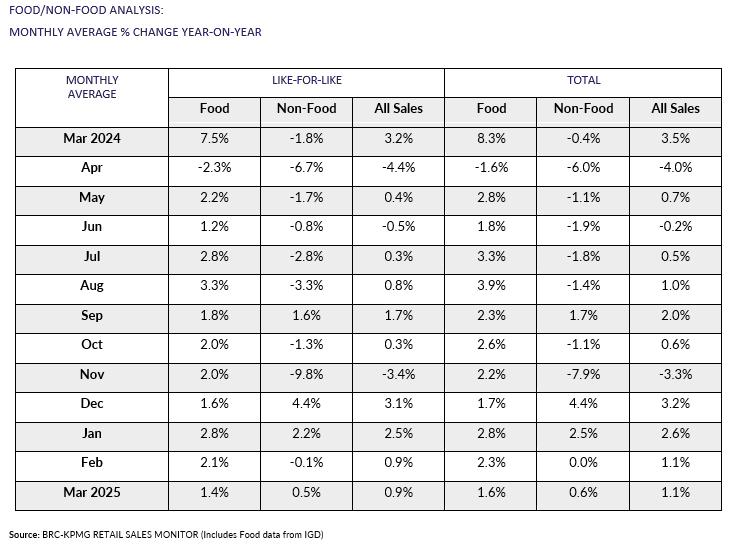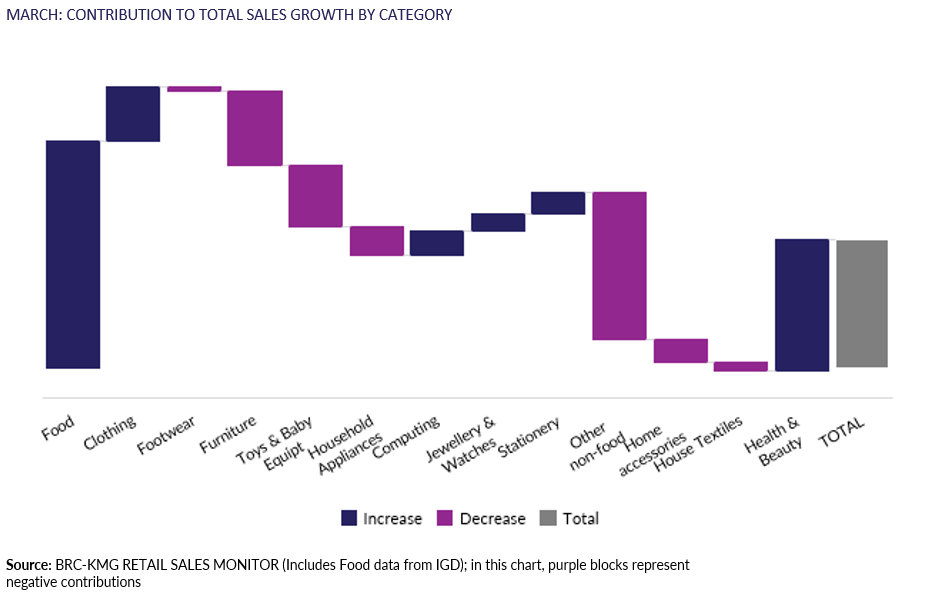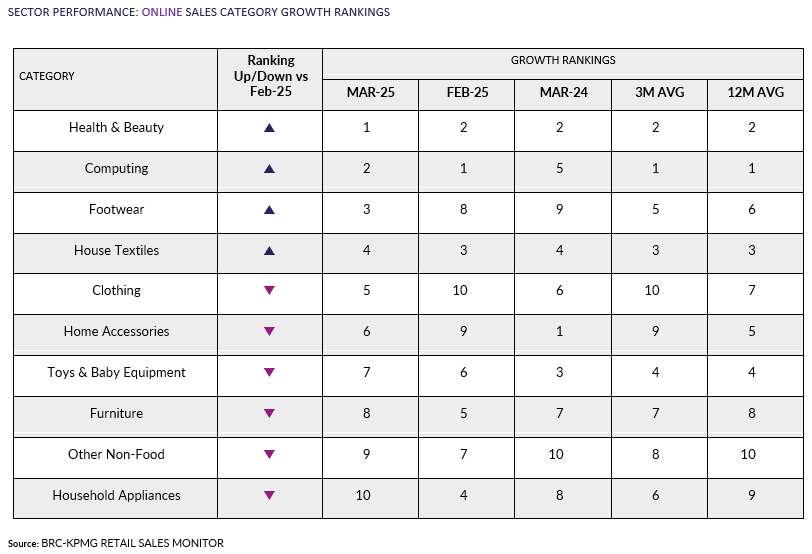BRC-KPMG RETAIL SALES MONITOR – March 2025
This year, Easter is in April, while last year it was in
March. This calendar change distorts the year on year sales
comparisons - resulting in an artificially higher April, but
lower March sales.
Covering the five weeks 02 March – 05 April
2025
-
UK Total retail sales increased by 1.1%
year on year in March, against a growth of 3.5% in March 2024.
This was below the 3-month average growth of 1.6% and above the
12-month average growth of 0.6%.
-
Food sales increased by 1.6% year on year
in March, against a growth of 8.3% in March 2024. This was
below the 3-month average growth of 2.3% and below the 12-month
average growth of 2.2%.
-
Non-Food sales increased by 0.6% year on
year in March, against a decline of 0.4% in March 2024. This
was below the 3-month average growth of 1.1% and above the
12-month average decline of 0.8%.
-
In-Store Non-Food sales decreased by 0.1%
year on year in March, against a growth of 0.1% in March 2024.
This was below the 3-month average growth of 0.6% and above the
12-month average decline of 1.7%.
-
Online Non-Food sales increased by 1.8%
year on year in March, against a decline of 1.4% in March 2024.
This was below the 3-month average growth of 1.9% and above the
12-month average growth of 0.9%.
-
The online penetration rate (the
proportion of Non-Food items bought online) increased to 37.1%
in March from 36.6% in March 2024. This was above the 12-month
average of 36.8%.
Helen Dickinson, Chief Executive of the British Retail
Consortium, said:
“Despite a challenging global geopolitical landscape, the small
increase in both food and non-food sales masked signs of
underlying strengthening of demand given March 2025's comparison
with last year's early Easter. The improving weather made for a
particularly strong final week, with gardening and DIY equipment
flying off the shelves. Jewellery and beauty products were helped
by Mother's Day, though sales of bigger ticket items like
furniture remained weak. Retailers are making final preparations
for Easter, with food expected to be the big winner next month.
“Since the start of April, retailers have had to contend with £5
billion pounds of new government-imposed costs as a result of
increases to the National Living Wage and National Insurance.
This rises to £7bn when the new packaging tax comes into effect
in October and will undoubtedly increase inflation later in the
year and hold back critical investment in high streets across the
country. Government has ample opportunities to kick start that
investment by ensuring that no shop pays more as part of their
planned reforms to business rates and that the Employment Rights
Bill doesn't reduce the availability of entry level and part time
jobs. Investment and growth are what the economy needs right
now.”
Linda Ellett, UK Head of Consumer, Retail & Leisure,
KPMG, said:
“As Spring weather arrived, house and garden related purchases
and gifts for Mother's Day drove retail sales growth in
March.
“Amidst downbeat consumer confidence in the UK's economic
outlook, and many households facing rising costs, retail sales
growth feels an achievement. But with non-food sales
only climbing around 1% on average, competition means there are
some retailers really struggling whilst others win, especially
online. Retailers will be pushing for higher growth rates
as we move toward summer and holiday season, particularly as they
are now paying higher wage costs and facing volatility and
potential impact on their supply chains due to global tariffs.”
Food & Drink sector performance | Sarah Bradbury,
CEO, IGD, said:
“Shopper confidence fell from 4 to -2 in March after a brief
boost in February. Rising geopolitical uncertainty and the
imminent increases in household bills will have contributed to
this decline. While half-term, Bank Holidays, and Easter may
temporarily lift sales, the potential negative impact of U.S.
tariffs and recession concerns are likely to keep confidence low.
We may have already seen the peak for some time.”






